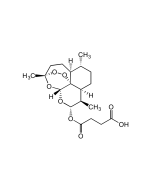Cookie Policy: This site uses cookies to improve your experience. You can find out more about our use of cookies in our Privacy Policy. By continuing to browse this site you agree to our use of cookies.
AdipoGen Life Sciences
Dihydroartemisinin
As low as
60
CHF
CHF 60.00
In stock
Only %1 left
AG-CN2-0468-M05050 mgCHF 60.00
AG-CN2-0468-M250250 mgCHF 130.00
AG-CN2-0468-G0011 gCHF 230.00

| Product Details | |
|---|---|
| Synonyms | Dihydroqinghaosu; Artenimol; DHA |
| Product Type | Chemical |
| Properties | |
| Formula |
C15H24O5 |
| MW | 284.3 |
| CAS | 71939-50-9 |
| RTECS | KD4165550 |
| Source/Host Chemicals | Isolated from Artemisia annua. |
| Purity Chemicals | ≥98% (HPLC) |
| Appearance | White solid. |
| Solubility | Soluble in DMSO or ethanol. |
| InChi Key | BJDCWCLMFKKGEE-ISOSDAIHSA-N |
| Smiles | [H][C@@]12CC[C@@H](C)[C@]3([H])CC[C@]4(C)OO[C@@]13[C@]([H])(O[C@H](O)[C@@H]2C)O4 |
| Shipping and Handling | |
| Shipping | AMBIENT |
| Short Term Storage | +4°C |
| Long Term Storage | +4°C |
| Handling Advice |
Keep cool and dry. Protect from light. Protect from moisture and oxygen. |
| Use/Stability | Stable for at least 1 year after receipt when stored at +4°C. |
| Documents | |
| MSDS |
 Download PDF Download PDF |
| Product Specification Sheet | |
| Datasheet |
 Download PDF Download PDF |
Description
- Active metabolite of artemisinin.
- Anti-malaria (Plasmodium).
- Anti-schistosoma.
- Apoptosis inducer.
- Anti-cancer.
- Anti-inflammatory
- Inhibits production of tumor necrosis factor-alpha (TNF-α), interleukin-6 (IL-6), monocyte chemotactic protein-1 (MCP-1) and nitric oxide (NO).
- Autophagy inducer.
- Functional ARX inhibitor.
- Enhancer of GABAA signalling.
- Targets Gephyrin.
- Sown to have anti-SARS-CoV-2 activity with an EC50 of 13.31 ± 1.24μM, and beeing potentially useful in the treatment of COVID-19.
Product References
- Qinghaosu (artemisinin): an antimalarial drug from China: D.L. Klayman; Science 228, 1049 (1985)
- Comparison of in vivo and in vitro antimalarial activity of artemisinin, dihydroartemisinin and sodium artesunate in the Plasmodium berghei-rodent model: C. J. Janse, et al.; Int. J. Parasitol. 24, 589 (1994)
- The development of the antimalarial drugs with new type of chemical structure--qinghaosu and dihydroqinghaosu: Y. Tu; SE Asian J. Trop. Med. Publ. Health 35, 250 (2004)
- Artemisinin induces apoptosis in human cancer cells: N.P. Singh & H.C. Lai; Anticancer Res. 24, 2277 (2004)
- Artemisinin attenuates lipopolysaccharide-stimulated proinflammatory responses by inhibiting NF-κB pathway in microglia cells: C. Zhu, et al.; PLoS One 7, e35125 (2012)
- In vivo activity of dihydroartemisinin against Schistosoma mansoni schistosomula in mice: H.J. Li, et al.; SE Asian J. Trop. Med. Publ. Health 44, 379 (2013)
- Differential effect of artemisinin against cancer cell lines: M. Tilaoui, et al.; Nat. Prod. Bioprospect. 4, 189 (2014)
- Dihydroartemisinin supresses inflammation and fibrosis in bleomycine-induced pulmonary fibrosis in rats: D. Yang, et al.; Int. J. Clin. Exp. Pathol. 8, 1270 (2015)
- Dihydroartemisinin increases temozolomide efficacy in glioma cells by inducing autophagy: Z.S. Zhang, et al.; Oncol. Lett. 10, 379 (2015)
- Artemisinins target GABAA receptor signaling and impair α cell identity: J. Li, et al.; Cell 168, 86 (2017)
- EXP1 is critical for nutrient uptake across the parasitophorous vacuole membrane of malaria parasites: P. Mesén-Ramírez, et al.; PLoS Biol. 17, e3000473 (2019)
- Anti-SARS-CoV-2 Potential of Artemisinins In Vitro: R. Cao, et al.; ACS Infect. Dis. 6, 2524 (2020)







